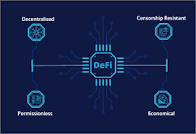IT IS YOUR MONEY
Real-World Assets Meet Decentralized Finance
Real-world assets (RWAs) are now powering decentralized finance (DeFi), bridging traditional value with blockchain efficiency. From tokenized bonds to real estate-backed loans, this fusion enhances yield opportunities and stability. Platforms like Maple Finance and Centrifuge lead the charge, enabling secure, transparent lending. This convergence marks a pivotal shift in digital finance.

The Convergence of TradFi and DeFi
For years, DeFi operated largely in a speculative realm—driven by volatile cryptocurrencies and algorithmic tokens. However, the integration of real-world assets (RWAs) is transforming DeFi into a more sustainable, yield-generating ecosystem. By collateralizing tangible assets such as invoices, real estate, or corporate debt, DeFi protocols can offer stable, income-producing opportunities backed by real economic activity.
This hybrid model combines the transparency and automation of blockchain with the intrinsic value of physical or legally recognized assets. It reduces reliance on purely crypto-collateralized loans, which are vulnerable to market swings, and introduces creditworthiness and cash flow-based lending.
How RWA Integration Works in DeFi
In RWA-powered DeFi, institutions or borrowers pledge real-world collateral—such as trade receivables or property deeds—which is verified and tokenized on-chain. These tokens serve as collateral for loans issued through smart contracts. Repayments, including interest, are automatically distributed to liquidity providers.
For example, Centrifuge allows businesses to tokenize invoices and use them as collateral to borrow stablecoins from DeFi pools. Investors earn yields backed by real-world cash flows, while borrowers access capital faster than through traditional banks.
Similarly, Maple Finance enables institutional borrowers—like fintech firms or asset managers—to secure unsecured loans from decentralized pools based on credit assessments conducted off-chain but enforced on-chain.
Notable Platforms and Use Cases
Centrifuge has facilitated over $500 million in RWA-backed loans, partnering with institutions like MakerDAO and Aave. In one case, a European renewable energy company raised $20 million by tokenizing future revenue from solar farms, offering investors predictable returns.
Maple Finance has issued over $1.2 billion in loans to creditworthy borrowers, including crypto-native firms and traditional SMEs. Its model uses “pool delegates”—trusted entities that underwrite borrowers—while preserving DeFi’s permissionless access.
Goldfinch, another RWA-focused protocol, enables global lenders to fund emerging market businesses, with repayments secured by real revenue streams rather than crypto collateral.
Challenges and Regulatory Outlook
Despite growth, RWA-DeFi integration faces hurdles. Legal enforceability of on-chain debt against off-chain assets remains complex. Jurisdictions must recognize smart contracts as binding agreements and establish frameworks for cross-border collateral recovery.
Additionally, data verification is critical. Oracles must reliably report real-world performance (e.g., loan repayments) to trigger smart contract actions. Solutions like Chainlink’s CCIP and decentralized identity systems are helping bridge this gap.
Regulators are watching closely. The EU’s MiCA framework and U.S. state-level initiatives are beginning to address hybrid financial models, paving the way for compliant innovation.
As the lines between traditional finance and DeFi blur, RWA integration is proving that digital finance can be both decentralized and grounded in real value. This evolution brings stability, accessibility, and new income streams to global investors.
To explore how RWA-backed DeFi can diversify your investment strategy, visit DigitalAssets.Foundation and speak with experts for a FREE consultation.

More News
© 2025
